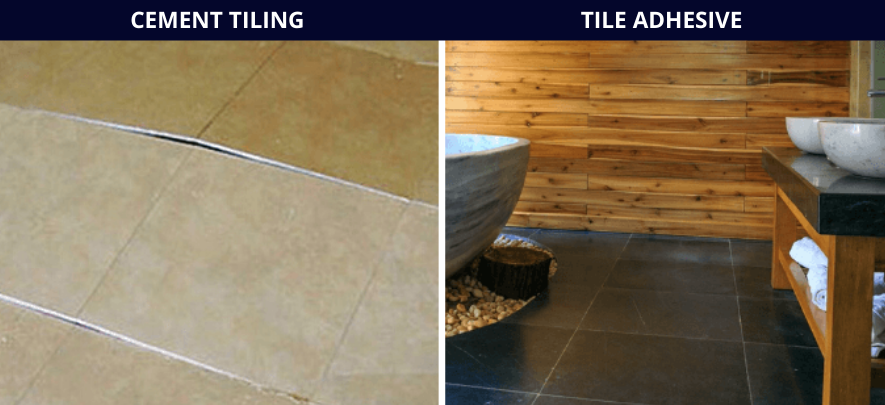Cement vs Tile Adhesive for laying tiles

Manufacturing & Production
210 week ago — 6 min read
What is Cement?
Cement is one of the most important building materials used in the construction industry.
Let’s understand how the cement is made, As we all know it's not some sort of natural growing ingredient from the earth. Cement is made in the controlled environment of industrial settings. Cement is made with a combination of the following chemical materials.
Lime 60-65%
Silica 17-25%
Alumina 3-8%
Magnesia 1-3%
Iron oxide 0.5-6%
Calcium sulphate 0.1-0.5%
Sulfur trioxide 1-3%
Alkaline 0-1%
As we know, after going through rigorous industrial grinding and chemical processes it attains strong adhesion properties. This makes cement the highest used material in the construction industry.
What is tile adhesive?
Tile adhesive is a premixed blend of exceptionally well-chosen ordinary Portland cement, well-graded fine sand, and added substances such as latex to improve its basic properties for laying tiles and giving it more strength and flexibility.
Each type of tile adhesive is made for a different type of surface application to give the best output to users based on the usage areas and atmosphere. Tile adhesive can be utilised for fixing a wide range of tiles and stones over different substrates.
These tile fixing adhesives are prepared to blend, self-restoring, and with astounding adhesion properties. Their superior bonding strength prevents shrinkage, breaks, and slippage of tiles.
The cohesion of cement & tile adhesives
Cement
For many years cement has been the most sought material for tile and stone laying. As the saying goes all materials have a good side and a bad side you have to look for both.
The inherent problem with cement mixture shrinks after drying and leaves hollow space below the tile surface. These hollow sounds one can hear while walking or using the floor. These are the weaker areas of the flooring and they can cause tile cracking or debonding from the substrate.
The cement and sand mixed with water dry really fast so chances of tile adjustment while laying tiles is really really quick or it won’t bond well.
The cement and sand slurry does have limitations to work well with the following tiles or stones.
- Low absorbent tiles
- Granito
- Glass mosaics - polished substrates
- Fixing tiles over tile
- On substrates with heavy movement
- On the areas with high pressure and impact
- Surface with thermal shock
Tile Adhesives
Tile adhesive comes in various forms the most used tile adhesive comes in powder forms. The tiles adhesive is really easy to work with does not need water curing.
The adhesive paste can be applied evenly on the surface with a notched trowel. Once the paste is spread across the surface uniformly it will create a strong bond between tile and surface.
Water curing is not needed with tile adhesive so the surface set in 24 hours and its ready to use. Tile adhesive has a consistent result with all forms of tile and stone.
- Low absorbent tiles
- Granito with 60 x 60 cm or greater size
- Glass mosaics - On polished substrates
- On existing tiles
- On substrates with heavy movement
- On the areas with high pressure and impact
- On the areas with thermal sock
Working with Cement and Tile adhesive
Laying tiles with Cement is surely a tedious and serious workload. The laying process is moderate and includes the soaking of tiles before the installation. The making of cement slurry is messy involves a lot of water and sand mixing sometimes the proportion can be wrongly calculated. It produces a lot of wastage material due to the messy environment.
Tile adhesives can be applied effectively and proficiently with the assistance of an indented scoop. This aids in maintaining a strategic distance from any future issues like tile-breaking, water-leaking, and frail securities with the substrate. Tiling tile adhesives is a lot quicker.
Economical Reasons
Cement is a widely available material and it cheaper as compared to tile adhesives. As stated cement has its ups and downs but surely for laying tiles & stones tile adhesive will be an effective choice given its properties and features.
Cement becomes messy and creates a lot of problems in the future keeping in mind for long-term usage of the place one needs to be careful while working with tile and stone.
If your flooring and walls are protected for a long time without giving you much maintenance cost I bet tile adhesive will be the right choice.
Tile and stone adhesive can be utilised for fixing a wide range of tiles and stones over different substrates. These tile fixing adhesives are prepared to-blend, self-restoring, and with astounding adhesion properties. Their superior bonding strength prevents shrinkage, breaks, and slippage of tiles.
To know more about how to use tile adhesive, link with me by clicking on the 'Invite' button on my eBiz Card.
Disclaimer: The views and opinions expressed in this article are those of the author and do not necessarily reflect the views, official policy or position of GlobalLinker.
Posted by
Hemant Kumar Lokpal JainHemant Jain has, over the last 25 years, managed and led the business to achieve pole position, across the adhesive industry for Tile & Stone fixing sector. He has led...
View Hemant 's profile
Most read this week










Comments
Share this content
Please login or Register to join the discussion